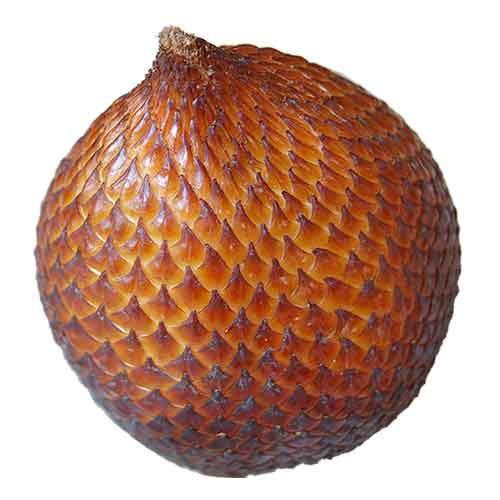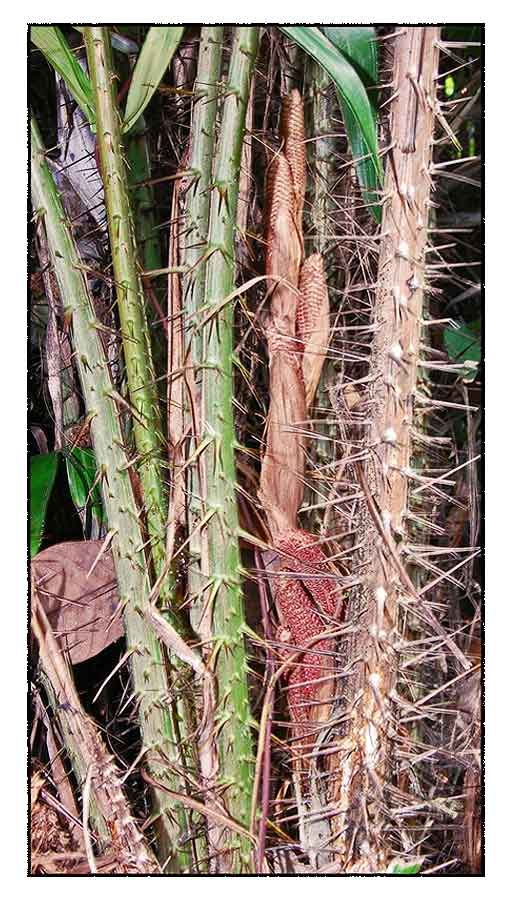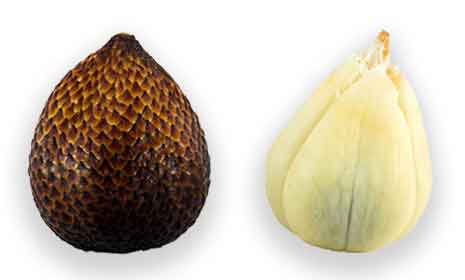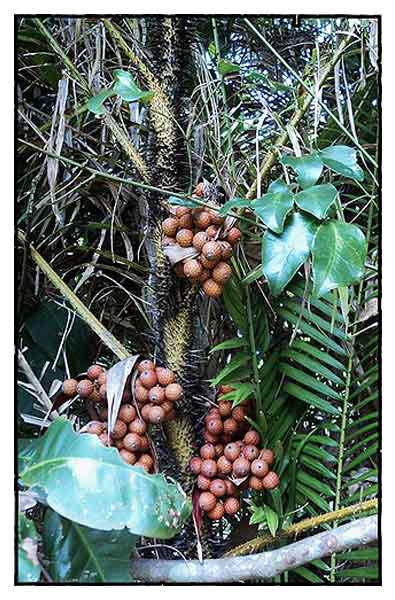 Gen info Gen info
- Salacca is a genus of about 20 species of palms native to Southeast Asia and the eastern Himalayas.
- The common name 'snakefruit' derives from the fruit skin with a unique texture similar to a snake's skin, rough to touch in one direction, smooth in the other.
(3)
- Etymology: Both Salacca and zalacca are Latinizations of the common name, the Malay "salak".
- The genus has had an interesting taxonomic journey: The salak palm was first named by Joseph Gaertner in 1791 as Calamus zalacca. In 1825 Caspar Reinwardt established the genus Salacca, and a year later described salak as Salacca edulis. In 1895, Andreas Voss pointed out Salak palm did indeed belong to the genus Salacca, and the taxonomic journey finally ended with Salacca zalacca. (4)
- In Indonesia, the production of salak or snake fruit has ranked 5th in national fruit production, with 5.65%, or 1,118,953 tons of salak production.
 Botany Botany
Salacca zalacca is a densely clustering palm with short and stout stems which may appear stemless (acaulescent). The leaves are large (3 – 7 m long), pinnate and arching with spiny petioles. Leaflets are long, dark green above and sliver-green beneath. Leaflets grow from the rachis in an almost flat plane, but are arranged into closely set groups of 3 -5. Leaflets are long, narrowly elliptic, dark green above and silvery green beneath. Female inflorescence (20 – 30 cm long) comprise of 1 – 3 spadices which are 7 – 10 cm long. Male inflorescence (50—100 cm long) comprise of 4 – 12 spadices which are 7 – 15 cm long. Male flowers have reddish tubular corolla and 6 stamens on the corolla throat, while female flowers have tubular corolla which are yellow green outside and dark red inside, with a red style. The fruit is a round to elliptical drupe, covered in imbricate scales which turn reddish brown to nearly red when ripe. Seeds are fleshy and usually occurs 3 per fruit. (5)
Distribution
- Introduced to the Philippines.
- Native to Jawa, Sumatera.
Constituents
- Phytochemical study of fruit yielded the presence of flavonoids, phenolics, glycosides, some volatile and aromatic compounds, including gallic acid, quercetin, chlorogenic acid, epicatechin, lycopene, proanthocyanidins, and ß-carotene. (6)
- Proximate analysis of fruit yields sucrose (7.6 g/100g),
fructose (5.9g /100g), total sugar (17.4 g/100g), soluble dietary fiber (0.3 g/100g), insoluble dietary fiber (1.4 g/100g), total dietary fiber (1.7 g/100g), water (80 g/100g), calories (77 kcal/100g), protein (0.7 g/100g), ash (0.6 g/100g), and fat (0.1 g/100g). (6)
 - Salak pulp contains minerals and vitamins:
phosphorous (1 161 mg/kg), potassium (11.339 mg/kg), calcium (220 mg/kg), magnesium (607 mg/kg), sodium (231 mg/kg), iron (12.0 mg/kg), manganese (10.4 mg/kg), copper (3.36 mg/kg), zinc (10.4 mg/kg), boron (5.07 mg/kg), sulfur (5.07 mg/kg), ascorbic acid (400 mg/kg), carotene (5 mg/kg), thiamine (20 mg/kg), niacin (240 mg/kg), riboflavin (0.8 mg/kg) and folate (6 mg/kg). (6) - Salak pulp contains minerals and vitamins:
phosphorous (1 161 mg/kg), potassium (11.339 mg/kg), calcium (220 mg/kg), magnesium (607 mg/kg), sodium (231 mg/kg), iron (12.0 mg/kg), manganese (10.4 mg/kg), copper (3.36 mg/kg), zinc (10.4 mg/kg), boron (5.07 mg/kg), sulfur (5.07 mg/kg), ascorbic acid (400 mg/kg), carotene (5 mg/kg), thiamine (20 mg/kg), niacin (240 mg/kg), riboflavin (0.8 mg/kg) and folate (6 mg/kg). (6)
- Pulp juice contains 1,130 and 2,997 μg in 100 g of sample of lycopene and β-carotene, respectively, vitamin A with 500 µg or retinol equivalent/100g of fruit. Vitamin C and polyphenol content was significantly high compared to mangosteen fruit with 13.28 mg ascorbic acid equivalent (AAE) and 8.46 mg gallic acid equivalent (GAE) per gram of fruit. (6)
- Study of snake fruit peel extract yielded flavonoids, tannin, phenol, triterpenoid, saponin, and alkaloids. Chlorogenic acid was around 1.074 mg/g dry weight. (see study below)
(7)
- Study of skin of fruits for phytochemical contents yielded alkaloids, triterpenoids, saponins, tannins, and flavonoids. (8)
- Mass spectrometric study of salak pulp detected 19 phenolic compounds including 5 flavanols, 6 phenolic acids, 2 flavonols, 1 flavone, and also 5 presumably new phenolic compounds. Chlorogenic acid was the most predominant phenolic compound, followed by epicatechin, isoquercetin, neochlorogenic acid, ferulic acid, gallic acid and procyanidine B2 (levels at ca 5–10 μg/g in MeOH extract), syringic acid, and caffeic acid (levels at ca 1 μg/g in H2O extract). A significant total phenolic content (257.17 μL/mL) and antioxidant activities. (20)
 Properties Properties
- Studies suggest antioxidant, antidiabetic, anti-anemic , adsorptive, wound healing, immunomodulatory, phytoremediative, antihypertensive properties.
Parts used
Fruits, peel, seeds.
Uses
Edibility
-Fruits are edible; ripe, eaten raw, sweet, slight crisp with an apple-like flavor; unripe fruits, sour and astringent, used in salads.
- In Indonesia, fruits are candied (manisan salak), pickled (asinan salak), fresh unripe ones used in 'rujak', a spicy salad of unripe fruit.
(2)
- Seed kernels of young fruits are edible.
- In Indonesia, salak is processed into various food products: Salak chips, bakpia salak, sweets, coffee, and dodol salak.
Folkloric
- No reported folkloric medicinal use in the Philippines.
-
In Malaysia, fruit used for treatment of diabetes.
- In Indonesia, used for treatment of diarrhea.
Others
- Crafts: Leaflets used for thatching; bark of petioles used for matting.
Studies
• Anti-Aging / Fruit Peel: Study evaluated the phytochemical content and anti-aging potency of snake fruit peel. The snake peel extract yielded chlorogenic acid of around 1.074 mg/g dry weight. Chlorogenic acid has high binding affinity towards matirx metalloproteinase (MMP-1) (-9.4 kcal/mol). Results suggest potential for possible use of snake fruit peel extract as antioxidant and anti-aging agent. (see constituents above) (7) Chlorogenic acid showed highest affinity among salak peel compounds against MMP-1, and rutin against NEP and PPO3. Intermolecular analysis revealed favorable interaction between chlorogenic acid and rutin towards respective protein. Results suggest possible inhibition of proteins related to skin aging and potential as anti-aging agent. (14)
• Antihyperuricemic / Fruit: Study have shown ability of salak fruit in stabilizing elevated uric acid and managing gout inflammation. The two compounds isolated in snake fruit namely 3β-hydroxy-sitosterol and 2-methylester-1- H-pyrrole-4-carboxylic acid were tested for their xanthine oxidase inhibition activity to alleviate the symptoms associated with gout. The first compound was regarded inactive and the latter exhibited a good activity with the IC50 value 48.86 μg/ mL. An in vivo study showed significant reduction in the serum uric acid level at 200 mg/kg body weight, after induction using potassium oxonate intraperitoneally and oral uric acid simultaneously. There was significant increase in the urine uric acid excretion as compared to the control group, although lower than the control drug (probenecid). The anti-hyperuricemia effect of the fruit extract was attributed to inhibition of xanthine oxidase activity. (6)
• Burn Wound Healing / Fruit Seed: Study evaluated the wound healing effect of betel nut and snake fruit in rats. Gel was formulated from EA extract of snake fruit seed and betel nut, and evaluated with parameters of wound contraction and epithelization period. Results showed significant wound contraction (p<0.05) and epithelization (p<0.05). While both extracts showed potential acceleration of burn wound healing, the betel nut gel was more effective than gel of snake fruit seed. (9)
• Antidiabetic Potential / α-Glucosidase Inhibitory Activity / Fruit: Study evaluated the α-glucosidase inhibitory activity of salak fruit extracts. A 60% hydroethanolic extract showed the highest activity, while the water extract exhibited the lowest. A combination of FT-IR fingerprint with α-glucosidase managed to identify the functional groups susceptible to be involved for α-glucosidase inhibitory activity, such as (C–H, C=O, C–N, N–H, C–O, and C=C) compounds containing this fractional groups (chlorogenic acid, caffeic acid, levodopa, ascorbic acid, and gallic acid), which could be responsible for α-glucosidase enzyme inhibitor. (10)
• Modulation of Metabolic Alterations in Obese Diabetic Rats M/ Fruit: Study evaluated the metabolic changes on obese-diabetic (OBDC) rats treated with S. zalacca fruit extract using protono-nuclear magnetic resonance (1H NMR)-based metabolomics approach. Results showed administration of 400 mg/kbw of 60% ethanolic extract for 6 weeks decreased blood sugar levels and normalized blood lipid profile of OBDC rats. Potential biomarkers in the urine were 2-oxoglutarate, alanine, leucine, succinate 3-hydroxybutyrate, taurine, betaine, allantoin, acetate, dimethylamine, creatine, creatinine, glucose, phenyl-acetylglycine, and hippurate. While the extract could not fully improved the metabolic complications of diabetic rats, it was able to decrease ketone bodies, improve energy metabolism, improve glucose, acetate, lactate, 2-hhydroxybutyrate, 2-oxoglutarate, citrate and succinate, and also decreased gut microflora, bile acid metabolism and creatine. Study supports the traditional claims of fruits for treatment of diabetes. (11)
• Antihyperglycemic and Immunomodulatory / Polyherbal: Study evaluated the anti-hyperglycemic and immunomodulatory effects of an antidiabetic polyherbal composed of Sesbania grandiflora seeds, Salacca zalacca leaves and Acalypha indica roots in STZ-induced diabetic mice. Results showed the polyherbal extract could suppress blood glucose elevation and preserve the pancreatic islet of diabetic mice, normalize the relative amount of activated CD4+CD62L- and CD8+CD62L- T cells, stimulate the production of CD4+CD25+FoxP3+ regulatory T cells (Tregs), which is known to play an important role in diabetes control. Polyherbal treatment also increased the relative amount of anti-inflammatory cytokines IL-10 and TGF. Results reveal the polyherbal extract has an anti-hyperglycemic and immunomodulatory activity of potential benefit for treatment of diabetes. (12)
• Antioxidant / Fruit: Phytochemical study of fruit yielded sources of antioxidants, i.e., polyphenols, flavonoids, tannins, and monoterpenoids. Antioxidant activity study of fruit extracts by DPPH method revealed higher values than shell, 82.675% vs 73.135%. (13)
• Protection Against Gestational Diabetes / Peel: Gestational diabetes is associated with insulin resistance that causes hyperglycemia, which can increase oxidative stress and increase inflammation and cell death that can hinder fetal growth and development. Study evaluated the effect of SZ peel extract in the expression of IL-1ß and cell death markers BAX and Apaf-1 in glucose 3% induced zebrafish embryo. Glucose metabolism was measure by level of phosphoenolpyruvate carboxykinase (PEPCK). Results showed decrease in PEPCK in the group given 3% glucose. SZ peel extract significantly decrease the expression of IL-1ß and Bax and decreased Apaf-1 expression. Study suggests the peel extract protects from gestational diabetes through decrease of IL-1ß, Bax, and Apaf-1. (15)
• Potential of Beverage through Fermentation of Fruit: Sugared snake fruit juices were fermented for 14 days with the Kombucha consortium containing yeasts and acetic acid bacteria. Fermentation enhanced antioxidant activity of snake fruit Kombucha by DPPH assay, with increases in phenolics, tannins, and flavonoids. Acetic acid was the major organic acid of the fermented produced that showed enhanced antibacterial activity by inhibition of S. aureus and E. coli. Results suggest snake fruits has potential for development into functional food beverages and foods. (16)
• Adsorption of Copper II / Peel: Study evaluated the adsorption of copper (II) onto activated carbon extracted from S. zalacca peel. Adsorption values were exothermic and spontaneous. The main mechanism controlling the adsorption process was physisorption. (17)
• Purification of Waste Cooking Oil / Improved Lipid Profiles / Skin: Waste cooking oil is widely used in traditional market, and its purification can avoid the amount of disposable oil, environmental pollution and health risk associated with oil consumption. Study evaluated the effect of treatment of two types of oil (chicken/fish-used oil and banana-used oil) with powder of skin of S. zalacca in a batch method. Optimum condition was achieved with 15 g of skin powder at two weeks contact time and 3 h shaking time. Results showed skin powder of S. zalacca could improve the quality of waste cooking oil by reducing MDA value and lipid profile (total cholesterol and LDL). Results suggest utilization of abundant waste agricultural products such as salacca skin can improve the health quality of oil consumption and avoid large amount of disposable oil and environmental pollution. (18)
• Benefit on Anemia in Female Adolescents / Herbal Jelly Combination: A randomized control trial evaluated the effect of consumption of jelly composed of salacca pondoh seed flour and Moringa leaf flour on hemoglobin levels in adolescent girls with moderate anemia. Treatment was given twice a week for 8 weeks. Results showed the administration of jelly combined with salacca seed flour and Moringa leaves is effective compared to plain jelly with iron tablets in increasing Hb levels. (19)
• Antidiabetic / α-Glucosidase Inhibitory Activity: Study evaluated the antidiabetic activity of S. zalacca fruit using α-glucosidase enzyme and profiling using GCMS. The 60% aqueous ethanolic extract exhibited highest bioactivity with IC50 of 16.90 µg/mL. Several α-glucosidase inhibitors such as stearic acid, palmitic acid, ß-sitosterol, myo-inositol were identified by GC-MS. Docking results predicted all metabolites identified to be in non-competitive mode involving majorly hydrophobic interactions with protein residues. In vitro assay strongly suggests the fruit to have potential antidiabetic activity. (21)
• Fe3O4@SiO2 Nanoflakes / Degradation of Dye Waste / Leaf Ash: Water pollution is a serious environmental problem relating to chemical-containing wastewater. Study reports on the synthesis of Fe3O4@SiO2 nanocomposite biogenic silica from S. zalacca leaf ash for the photo-Fenton-like degradation of dye waste. The material exhibited photocatalytic oxidation of batik wastewater as the removal of total suspended solids, chemical oxygen demand, and color reached 95.55%, 89.59%, and 90.00%, respectively. (22)
• Bio-Adsorbent / Remazol Brilliant Blue / Seed Charcoal: Study evaluated the efficacy of bio-adsorbent concentration of snake fruit seed charcoal in absorbing Remazol Brilliant Blue levels. Snake fruit seed was a carbon source that can be used as base material for activated carbon and adborbent for Remazol Brilliant Blue dye and can reduce the impact of textile dye waste pollution. (23)
• Silver Nanoparticles / Antibacterial / Fruit: Study reports on the synthesis of silver nanoparticles using a green one-pot method using an extract of snake fruit. Antibacterial testing of AgNPs by disc diffusion method showed activity against Staphylococcus aureus and Salmonella typhi. (24)
• Liquid Soap / Antioxidant / Peels: Study evaluated the antioxidant activity of 96% ethanol peels extract and the formulated soap from the extract. Antioxidant activity was assessed by DPPH assay. Extract showed antioxidant IC50 of 62.08 ppm, while the formulated soap showed IC50s of 139.65 ppm, 73.2 ppm, and 55 ppm for Formula 1, 2, and 3 respectively. Study showed the 96% ethanol extract has potential as source of natural antioxidants that can be developed in liquid soap preparations. Formula 3 with 3% S. zalacca 96% ethanol extract showed the best formula against free radicals with IC50 of 62.08 ppm as moderate antioxidant. (25)
• Anti-Inflammatory / Antioxidant / Peels: Study of ethanolic extract of S. zalacca peels extract showed potential as an antioxidant and anti-inflammatory agent through the decrease of intracellular ROS levels and anti-inflammatory abilities to decrease pro-inflammatory cytokine (TNF-α) and increase anti-inflammatory cytokine (IL-10) on lead-poisoned human fibroblast cells. (26)
• Antioxidant / Hypoglycemic / Antihypertensive / Fruit, Peel, Kernel: Study evaluated the antioxidant activity of peel, fruit and kernel of Salak fruit and hypoglycemic and antihypertensive properties of peel extracts. Methanol fruit extracts exhibited highest total phenolic content (TPC 10.27 mg GAE/g), total flavonoid content (TFC 0.37 mg CE/g), and antioxidant properties among all extracts. Peel extracts showed some extent of ACE and alpha-amylase inhibition, with methanol and peel extracts showing no significant difference (p<0.05) ACE (98%) and alpha-amylase (90%) inhibition activities. Results suggest the fruit exhibited highest antioxidant activity, followed by peel, and lastly, the kernel. Peel extracts also showed ACE and alpha-amylase inhibition activities. (27)
• Pyrolisis of Seed / Toxicity of Smoke and Mortality of Artemia salina Leach Larvae: The waste of salak is about 35-44% of processed or consumed salaks, with seed having a higher percentage of waste compared to skin, 25-30% vs 10-14%. Pyrolisis of 10 kg of salak seed produces liquid smoke with 10% yield. Fractional distillation of 1 kg of salak seed liquid smoke yielded 13% from fraction 3 (F3). Mortality test for F3 with concentration of 1000 ppm and 100 ppm gave 100% mortality to Artemia salina Leach larvae. GC-MS analysis of F3 identified 18 compounds, grouped into three: acetic acids and derivatives, phenols and derivatives, and ketones and derivatives. The three group compounds are predicted to possess toxic activity and capable of killing Artemia salina Leach larvae with LC50 of 23.44 ppm. (28)
• Effect of Salacca Vinegar on Lipid Profile: Study evaluated the effect of Salacca vinegar var. Suwaru on the diabetic profile of STZ-induced male rats. Salacca vinegar was given to 2 or 4 groups at doses of 0.4cc and 0.7 cc. Results showed both doses influenced lipid profile as evidenced by decrease in LDL, triglyceride, total cholesterol, and increase in HDL in serum plasma of diabetic rats. (29)
• Effect of Calcium and Boron on Quality and Nutrient Composition: The most prevalent problem of salak fruit is the occurrence of localized fresh necrosis causing cell collapse and color change from orange to dark brown, usually occurring when fruits mature and reach harvesting stage during the rainy season. Study evaluated whether flesh necrosis is related to Ca and B deficiencies and if it can be reduced by applying Ca and/or B via soil or foliar application. Results showed Ca application significantly reduced the number of fruit necrosis from 63,2% to 24.9%. Application of B had no effect in reducing the number of necrotic fruits. Surprisingly, the Ca, B, and Mg concentrations in necrotic tissue were higher than normal. Despite this discrepancy in tissue Ca association with necrotic tissue, results confirmed the incidence of necrosis can be reduced by application of soil Ca. (30)
• Biosorbent for Hg2+ Removal / Skin: A chemically modified-biosorbent was prepared by attaching dithizone onto Salacca zalacca skin waste for Hg2+ bioremoval. The material demonstrated high removal efficiency during Hg2+ adsorption, which fit pseudo-second-order kinetics. (31)
Availability
Wild-crafted.
Seeds in the cybermarket.
|

![]()







